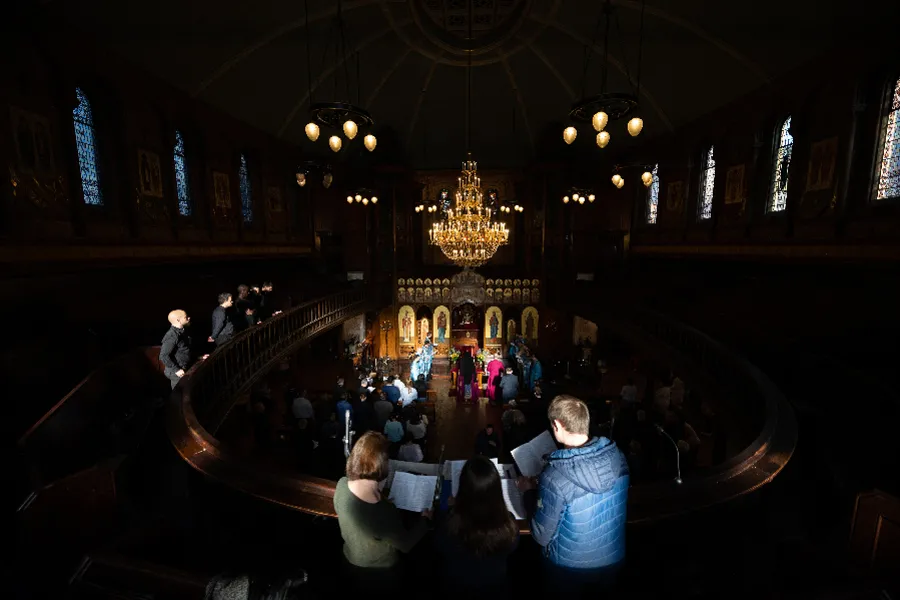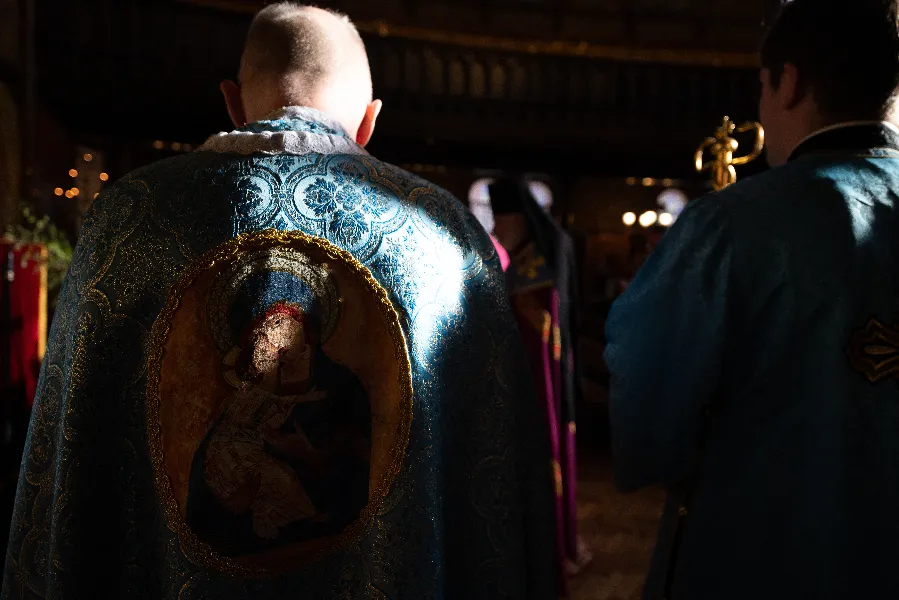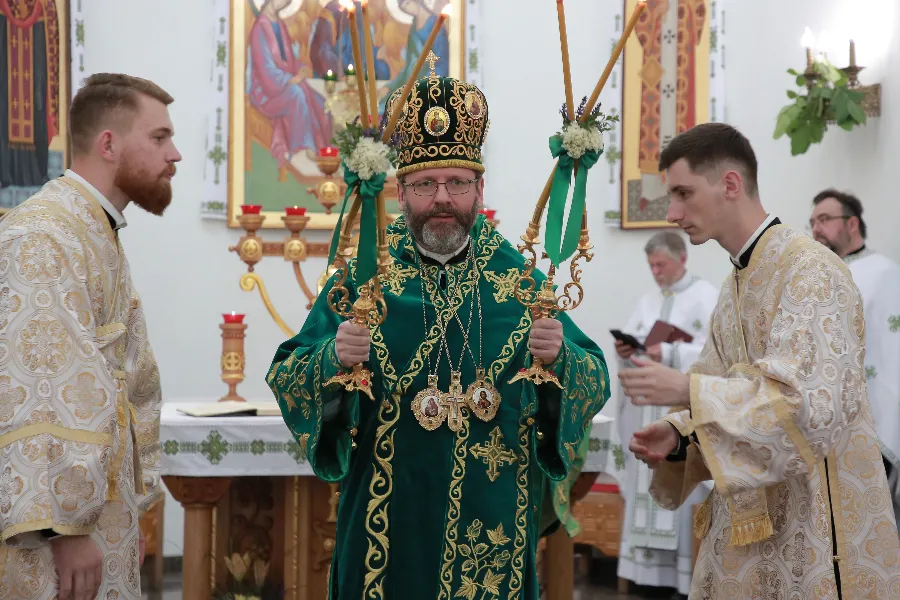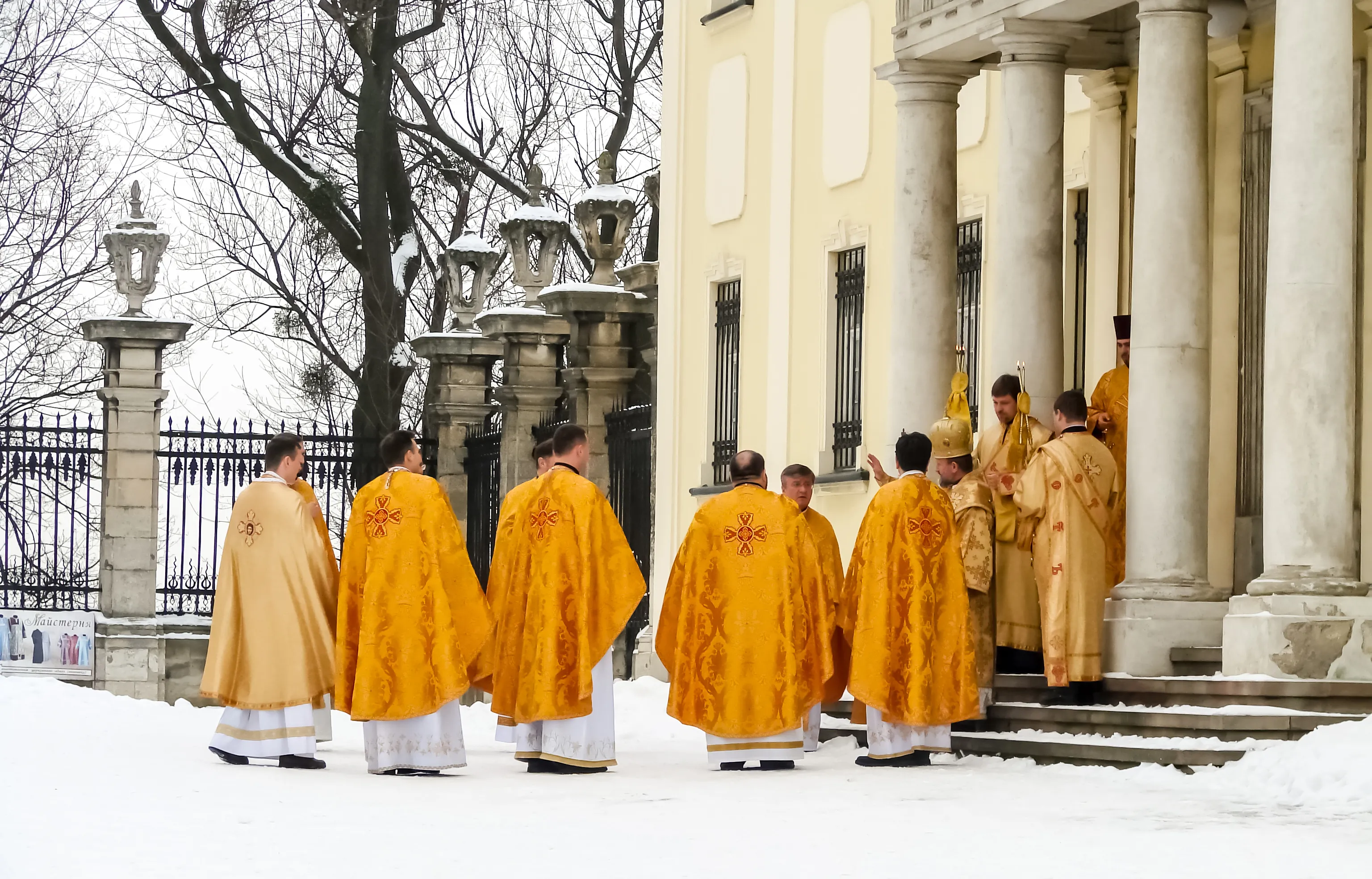
Rome Newsroom, Apr 15, 2022 / 06:00 am (CNA).
The Ukrainian Greek Catholic Church (UGCC) has come to global attention following Russia’s full-scale invasion of Ukraine in February. But many Western Catholics know little about the turbulent history of the largest of the 23 Eastern Catholic Churches in communion with Rome.
The year 1946 was a turning point for Ukrainian Greek Catholics. On March 8-10 that year, a gathering known as the “Pseudo-Synod of Lviv” took place. Under intense pressure from the Soviet authorities, the synod declared that the UGCC was under the jurisdiction of the Russian Orthodox Church.
Ukrainian Greek Catholics were presented with a stark choice: Merge into the Moscow Patriarchate or face persecution. Almost all of the UGCC’s members chose persecution and many left Ukraine.
The UGCC remained faithful to its identity between 1946 and 1981, the year that Pope John Paul II promoted the first Ukrainian Greek Catholic bishops’ meeting in Rome since the diaspora began.
As it spread around the world, the UGCC kept the Ukrainian language and traditions, preserving the memory of its history.
And so, when the Soviet Union dissolved in 1989, it was ready to reestablish itself in its homeland. It has since become a key reference point for Ukrainians around the world.

Communities from Australia to Argentina
Along with the 22 other Eastern Catholic Churches, the UGCC is sui iuris, or autonomous, but in full communion with the pope. It is led by a major archbishop and has a synodal structure.
The UGCC’s historical roots are entwined with Eastern Orthodoxy. It considers the Ecumenical Patriarchate of Constantinople as the Mother Church and it formally joined with Rome at the Union of Brest in 1595. Today, it has tens of eparchies spread over four continents.
In addition to its Ukrainian territory, it now has archieparchies in Canada, the United States, and Brazil, as well as an eparchy in Argentina and another in Australia, which are suffragans of the archdioceses of the Latin Rite of the city in which they are established.
There is also an administration in Poland and eparchies in France and Britain, as well as one that includes Germany, Denmark, Norway, and Sweden, and a recently established exarchate in Italy.
The Church takes the pastoral care of its members around the world seriously: in 2020, a bishop was appointed to work full time with the UGCC’s migration ministry office.

A visionary leader
All this is the legacy of Metropolitan Andrey Sheptytsky. He led the UGCC from 1901 to 1944, through two wars, the communist revolution, and the Soviet repression.
When Sheptytsky began his mandate, the UGCC had only three eparchies in western Ukraine under the rule of the Austro-Hungarian Empire. Sheptytsky was the first to make pastoral trips to visit the faithful in every part of the globe, doing everything necessary to send priests and bishops to take care of them.
He visited Russia in 1907 and 1912, and also Belarus. He created an apostolic vicariate in Bosnia. In 1907, he was appointed bishop of the Greek Catholic Church in the U.S., and in 1912, he was called to care for the Ukrainian community in Canada.
Sheptytsky used the popular language and made himself understood. He also provided scholarships to young Ukrainian artists so that they could be educated at the best European institutions.
Between the two world wars, Sheptytsky worked to develop the UGCC. On his initiative, the Greek Catholic Theological Academy in Lviv was founded in the late 1920s.
During the Second World War, Sheptytsky raised the problem of uniting all Ukrainian Christians around the Kyiv patriarchate and in continuity with Rome. As a result, he called the first Ukrainian Greek Catholic bishops’ meeting in Rome in 1929.
It is no coincidence that Ukrainian Greek Catholics dream of the canonization of Metropolitan Sheptytsky. His beatification process has opened and his heroic virtues were recognized in 2015.
His beatification would be a symbolic gesture giving recognition to a Church that suffered in silence during the war and then came out of the catacombs.
When it emerged, it initially faced much hostility and struggled to regain its churches, which were confiscated under the Stalin regime.

A landmark catechism
If today the UGCC is global, it is also partly due to the publication of “Christ – Our Pascha,” a catechism specifically created for the Ukrainian Greek Catholics. The catechism was innovative because it didn’t simply adapt the texts of Latin Rite catechisms — a practice that, according to the UGCC’s Major Archbishop Sviatoslav Shevchuk, created a “doctrinal Latinization.”
“Christ – Our Pascha” is an original catechism in which the primacy of Peter is confessed in an Eastern way, according to, in Shevchuk’s words, “the Byzantine vision of the catholicity of the Church as a communion of local Churches, guaranteed and promoted by the Successor of Peter as a visible bulwark and supreme servant of the universal communion of the Church of Christ.”
In 2019, the UGCC’s bishops decided to survey the faithful all over the world to understand what binds them with the Ukrainian Greek Catholic Church. The vast majority said that they identified with Eastern spirituality and the tradition of the Kyiv Church.
This finding prompted Shevchuk to say: “It is no longer the nation and the language that is the foundation of the Ukrainian Greek Catholic Church, but the experience of the incarnation of the word of God in the flesh and the history of the community of our Church.”

Creating a common front in Ukraine
Even though it is now a global Church sui iuris, the UGCC maintains a distinctive national structure. In recent years, even during the “Revolution of Dignity” in 2014, it has tried to strengthen the identity and spirit of the Ukrainian nation.
The UGCC has not focused on minority rights — as it might have been expected to in a predominantly Eastern Orthodox country. Rather, it has emphasized the importance of strengthening Ukraine as a just, multi-ethnic state. It has worked closely with the Ukrainian Council of Churches and Religious Organizations (UCCRO), in an attempt to create a common front to help people beyond their religious affiliation.
The UGCC is based in a country that experienced the worst of the European traumas of the 20th century and has been in a state of constant conflict with Russia since 2014. But some precedents may bode well for its future. And here again, we must return to John Paul II.

A model for reconciliation
The Polish pope promoted the first meeting of the representatives of the Polish episcopate and the Ukrainian Greek Catholic Church, which was held in Rome in 1987.
It was the last of the great reconciliations following the Second World War. First, there was the reconciliation between French and Germans. Then between Germans and Poles, promoted by Cardinal Bolesław Kominek. And finally, between the Ukrainian Greek Catholic Church and the Polish Church.
Two episodes led to the need for reconciliation. The first was the ethnic cleansing of Poles by Ukrainian nationalists in Volyn (also known as Volhynia) in 1943. The nationalists were supported by the local population. Russians, Jews, Armenians, Czechs, and other minorities were also victims of the massacre.
The second was Operation Vistula: the deportation in 1947 of more than 200,000 Ukrainians residing within the new southeastern borders of Poland. The official objective of the operation, carried out by the Polish communist government with the help of the Soviet Union and Czechoslovakia, was the suppression of the Ukrainian Insurgent Army (UPA). The massacre of Polish civilians in the southeastern territories was attributed to the UPA.
The 1987 meeting in Rome was about these episodes. Representatives of the UGCC were present, despite the Church being in diaspora after the Pseudo-Synod of Lviv, because it was considered the most lively representation of Ukrainian sensitivities and history.
Perhaps it will be the UGCC’s fate to start a path of reconciliation when the war is over. But it will have to do so as a bridge between East and West, perhaps seeking contact with the Moscow Patriarchate and overcoming the divisions that led to the Orthodox schism and the creation of the Orthodox Church of Ukraine.
Like all the sui iuris Churches, the UGCC remains a deeply national Church. Yet its totality is so universal that it has parishes abroad where first-generation Ukrainian immigrants are no longer the majority, which can be an essential asset on the path to peace. This is the challenge that faces it in the future.
If you value the news and views Catholic World Report provides, please consider donating to support our efforts. Your contribution will help us continue to make CWR available to all readers worldwide for free, without a subscription. Thank you for your generosity!
Click here for more information on donating to CWR. Click here to sign up for our newsletter.





“Perhaps it will be the UGCC’s fate to start a path of reconciliation when the war is over. But it will have to do so as a bridge between East and West, perhaps seeking contact with the Moscow Patriarchate and overcoming the divisions that led to the Orthodox schism and the creation of the Orthodox Church of Ukraine.”
Given its complicity with the Ukrainian government and collaboration with Constantinople, the UGCC will not play this role. This is worse than wishful thinking.
The caption on one photo needs to be corrected. Those aren’t cassocks. The priests are wearing “phelonion” which are the Eastern equivalent to the Western chasuble.
Good article though! Ukrainian Catholics are good people and a blessing to the universal Church. Rome should cherish and nurture them and not see them as an obstacle to reunion with the Orthodox (especially the Russian Patriarchate which has lost all religious and moral credibility).
The Pseudo-Synod of Lviv in March of 1946 was a complete sham. It was not convened by church authorities and all the UGCC bishops were in prison, even tortured. It was orchestrated by secular authorities and was typical of the behavior by Russian communists, as it is even today. See: http://news.ugcc.ua/en/articles/was_the_socalled_lviv_sobor_of_1946_really_a_church_council_92575.html